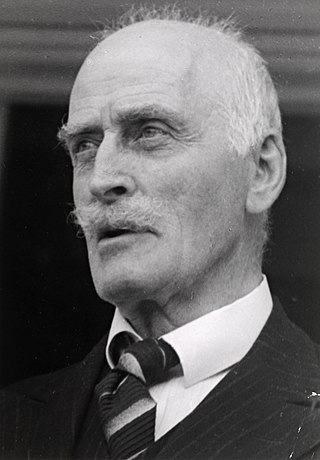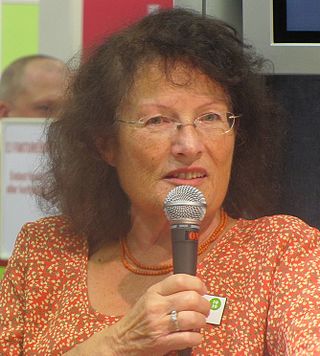
Knut Hamsun was a Norwegian writer who was awarded the Nobel Prize in Literature in 1920. Hamsun's work spans more than 70 years and shows variation with regard to consciousness, subject, perspective and environment. He published more than 23 novels, a collection of poetry, some short stories and plays, a travelogue, works of non-fiction and some essays.
Norwegian literature is literature composed in Norway or by Norwegian people. The history of Norwegian literature starts with the pagan Eddaic poems and skaldic verse of the 9th and 10th centuries with poets such as Bragi Boddason and Eyvindr Skáldaspillir. The arrival of Christianity around the year 1000 brought Norway into contact with European medieval learning, hagiography and history writing. Merged with native oral tradition and Icelandic influence, this was to flower into an active period of literature production in the late 12th and early 13th centuries. Major works of that period include Historia Norwegie, Thidreks saga and Konungs skuggsjá.
Transgressive fiction is a genre of literature which focuses on characters who feel confined by the norms and expectations of society and who break free of those confines in unusual or illicit ways.

Mary Chavelita Dunne Bright, better known by her pen name George Egerton, was a writer of short stories, novels, plays and translations, noted for her psychological probing, innovative narrative techniques, and outspokenness about women's need for freedom, including sexual freedom. Egerton is widely considered to be one of the most important writers in the late nineteenth century New Woman movement, and a key exponent of early modernism in English-language literature. Born in Melbourne, Colony of Victoria, she spent her childhood in Ireland, where she settled for a time, and considered herself to be "intensely Irish".

Per Petterson is a Norwegian novelist. His debut book was Aske i munnen, sand i skoa (1987), a collection of short stories. He has since published a number of novels with good reviews. To Siberia (1996), set in the Second World War, was published in English in 1998 and nominated for the Nordic Council Literature Prize. I kjølvannet, translated as In the Wake (2002), is a young man's story of losing his family in the Scandinavian Star ferry disaster in 1990 ; it won the Brage Prize for 2000. His 2008 novel Jeg forbanner tidens elv won the Nordic Council Literature Prize in 2009, with an English translation published in 2010.

Hunger is a novel by the Norwegian author Knut Hamsun published in 1890 by P.G. Philipsens Forlag. The novel has been hailed as the literary opening of the 20th century and an outstanding example of modern, psychology-driven literature. Hunger portrays the irrationality of the human mind in an intriguing and sometimes humorous manner.

Mysteries is the second novel by Norwegian author Knut Hamsun.
Scandinavian literature or Nordic literature is the literature in the languages of the Nordic countries of Northern Europe. The Nordic countries include Denmark, Finland, Iceland, Norway, Sweden, and Scandinavia's associated autonomous territories. The majority of these nations and regions use North Germanic languages. Although the majority of Finns speak a Uralic language, Finnish history and literature are clearly interrelated with those of both Sweden and Norway who have shared control of various areas and who have substantial Sami populations/influences.

Growth of the Soil is a novel by Knut Hamsun which won him the Nobel Prize in Literature in 1920. It follows the story of a man who settles and lives in rural Norway. First published in 1917, it has since been translated from Norwegian into many languages including English. The novel was written in the popular style of Norwegian new realism, a movement dominating the early 20th century. The novel exemplified Hamsun's aversion to modernity and inclination towards primitivism and the agrarian lifestyle. The novel employed literary techniques new to the time such as stream of consciousness. Hamsun tended to stress the relationship between his characters and the natural environment. Growth of the Soil portrays the protagonist (Isak) and his family as awed by modernity, yet at times, they come into conflict with it. The novel contains two sections titled Book One and Book Two. The first book focuses almost solely on the story of Isak and his family and the second book starts off by following the plight of Axel and ends mainly focusing on Isak's family.

Sigurd Hoel was a Norwegian author and publishing consultant, born in Nord-Odal. A prolific writer and critic, during the World War II he was a member of the Norwegian resistance movement.

Sigrid Combüchen is a Swedish novelist, essayist, literary critic and journalist.
In 1945 at the age of 86, the Nobel laureate novelist Knut Hamsun wrote an obituary of Adolf Hitler in the newspaper Aftenposten. Hamsun's eulogy to Hitler served as the collaborationist newspaper's feature article on Hitler's death. The obituary came to be his most infamous written piece.
Rolf Nyboe Nettum was a Norwegian literary historian and professor at the University of Oslo.

Gabriel Langfeldt was a Norwegian psychiatrist. He was a professor at the University of Oslo from 1940 to 1965. His publications centered on schizophrenia and forensic medicine. He was involved as an expert during the trial against Hamsun, and wrote a book about Quisling.

The Half Brother is a 2001 novel by the Norwegian writer Lars Saabye Christensen. The story follows a man who grows up in Oslo after World War II, with his mother, grandmother, great grandmother and half brother. The novel was published in Norwegian by Cappelen in 2001, and in English for the first time in 2003. It received the Brage Prize and the Nordic Council Literature Prize. A television series based on the novel was broadcast on NRK in 2013.

Ute av verden is the 1998 debut novel by Norwegian writer Karl Ove Knausgård. Knausgård was awarded the Norwegian Critics Prize for Literature for the book. This was the first time in the award's history that a first-time author had won.
Dreamers is a novel by Knut Hamsun from 1904. The novel is among Hamsun's last set in Nordland and it contains many comical and caricatured people and events.
Sverre Lyngstad was a scholar and translator of Norwegian literature. He is renowned for his significant contribution to making Norwegian literature accessible to an English-speaking audience, for which he was awarded the St. Olav's Medal in 1987 and the Royal Norwegian Order of Merit, Knight's Cross, First Class in 2004. He is best known for his translations of and commentaries on the works of Knut Hamsun, which are widely credited for helping to popularise Hamsun's work in the US and UK.
The Last Joy is the third book in Knut Hamsun's "wanderer trilogy." The novel was published in 1912, when Hamsun was just over 50 years old and had much of his writing ahead of him, but already knew the weight of age. The novel is set in the first person; the narrator has lived his life and now has the last joy of opting out of everything and just being with himself in nature. However, in Hamsuns's manner he cannot do it without revealing his self-deception.

The Ring is Closed was the last novel by the Norwegian author Knut Hamsun. The book was published in 1936. In it, Hamsun writes once again about love that creates a fatal flaw for one party in a relationship.












